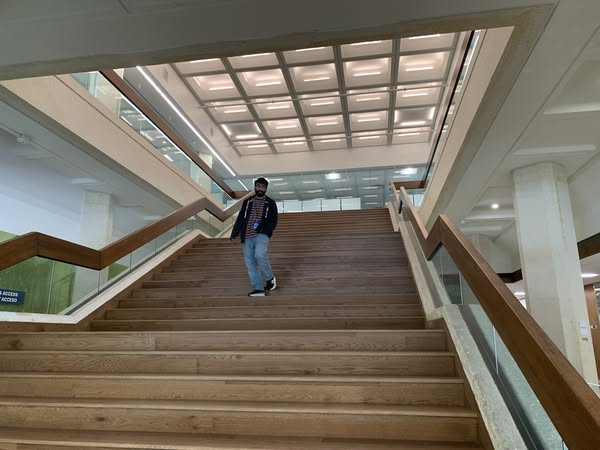Bicente Gutierrez descends the grand staircase in the new Austin History Center addition in the John Henry Faulk Building.
Michael Barnes/American-Statesman
On Thursday, Oct. 9, I was determined to be the first curiosity seeker to explore the newly opened Austin History Center addition inside the modernist John Henry Faulk Building at 800 Guadalupe St.
Article continues below this ad
Your history columnist waited patiently for a full 60 seconds to gain access at high noon.
After greeting some of the center’s leaders and absorbing the first-floor exhibition on the subject of — what else? — archives, I was escorted to the elevators to reach the second-floor reading room. (The third and fourth floors consist of offices, archives and collections.)
After signing in — the first to do so — I recorded my research topic — “ghost signs” — then stored my canvas satchel in one of the handy lockers near the reception desk. By the time I had settled into one of the sleek chairs and work tables, Jennifer Hecker, the lively head of reference services, had delivered a box neatly labeled “signs.”
Article continues below this ad
A medium-sized manila folder inside the gray box held several dozen photos protected in transparent sleeves. After paging tenderly through the first few artifacts, careful to keep them exactly in the existing order, I found what I sought: several small black-and-white and gray photos of “ghost signs.”
What the heck are ghost signs?
A photograph of this old “ghost sign” for Cecil’s Barbecue is housed at the Austin History Center.
Austin History Center, PICA 29494
I had stumbled on the term “ghost signs” only days before my visit to the history center. A local reader had posted some images on a public Facebook page titled, helpfully, “Ghost Signs.”
Article continues below this ad
This group of digital aficionados has attracted more than 85,000 members with its bounty of photographs and carefully curated conversations.
It is dedicated to “old wall signs from yesteryear, still barely shining through.”
What a charming concept!
Many social media pages collect images of vintage signs and novelty businesses. This site shares, in particular, those painted directly on exterior surfaces of buildings, vehicles and anything, really, other than billboards that have aged to a certain extent.
Article continues below this ad
My introduction to the group started here:
Jenny Schlosser, who lives in Austin, was among those who posted or reposted evocative images of the Blue Bonnet Court at 4407 Guadalupe St. not far from the University of Texas campus. “The Blue Bonnet was built in 1929 and was originally called the Bluebonnet Tourist Camp. The old sign is reported to be the first neon sign in Austin. The property is now apartments.”
Schlosser also posted images of the Avenue B Grocery in Hyde Park, which include some newer signs, but also faded glories from the past. The store’s website announces: “Avenue B Grocery & Market is Austin’s oldest continuously operated grocery store. No guarantees on hours or inventory. Open whenever the ‘V for Victory’ light is on. Opened 1909.” In my experience, the sandwiches are freshly made and excellent.
By Oct. 10, Schlosser’s Oct. 2 post about Blue Bonnet and Avenue B had attracted 2,800 likes, 177 comments and 171 shares. Several group members chimed in with their memories of the two historic sites. Conclusion: There’s an audience out there for “ghost signs.” I’ll no doubt while away the hours on this page.
What else did you find out about ghost signs and other Austin murals?
This “ghost sign” still can be spotted in the western alley at 109 E. Fifth St. The Studebaker dealership was owned by the Benson brothers, one of them the father of golfer Walter Benson III.
Austin History Center, PICA 29491
Back at the history center, I discovered a half-dozen small photos of ghost signs. One, a mural painted on cut stone, advertised “Cecil’s Barbeque.” As often was the case, the sign was sponsored by a national brand, this one 7-Up. Two cartoon bubbles about the 7-Up experience read “You Like It” and “It Likes You.” A little creepy.
Article continues below this ad
Another ghost sign plays with a downtown brick building’s architecture. A thin arch punctures the brick façade. The old window inside the arch is protected by metal bars. The sign muralist encircled the upper arch with an automobile or wagon wheel, then stroked that circle through with the word “Studebaker.” Below are the words “Benson Motor Co.”, partially obscured by the arch.
Turns out, I profiled a descendant of the car dealer in 2020: “From golf to racehorses: The many lives of Austinite Walter Benson, 103.” During the 1930s, his father, Walter Benson Jr., and his uncle, Matt Benson, opened a business at 109 E. Fifth St. that was both a motor company and a publishing house. The ghost sign is still there in the western alley.
Murals have proliferated in Austin, but how many of them qualify as signs, much less ghost signs? For instance, artist and musician Daniel Johnston’s famed “Hi, How Are You” mural at 21st and Guadalupe streets was preserved when the Goodall Wooten complex was demolished. Especially framed by the ruins behind it, the mural fragment looks like a sign, and in a larger sense, it is, but it doesn’t advertise anything other than good feelings.
Article continues below this ad
To track Austin’s murals, which can disappear and reappear, consult the blog, “MuralLove,” maintained by artist Josh Ronsen. Reference expert Hecker had recommended the site, launched in 2010 and still active. Ronsen and friends have tracked hundreds of murals, not all of them in Austin. Smartly, they are cross-referenced by artist and location. Not surprisingly, the winning ZIP Code is 78702, home to Central East Austin, with 212 entries. Ronsen is looking for someone to take over the blog. We owe him a huge debt of gratitude for this crucial documentation.
Please send tips and questions for “From the Archives” to mbarnes@statesman.com.

